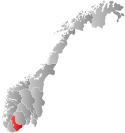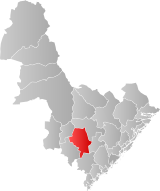Vegusdal is a former municipality in the old Aust-Agder county in Norway. The 325-square-kilometre (125 sq mi) municipality existed from 1877 until its dissolution in 1967. It was located in the northwestern part of the present-day municipality of Birkenes in Agder county. The administrative centre of the municipality was the village of Engesland where Vegusdal Church is located. The Norwegian County Road 405 (Fv 405) runs through Vegusdal south to the village of Mosby in Vennesla.[1]
Vegusdal Municipality
Vegusdal herred | |
|---|---|
 View of the local Vegusdal Church | |
 Aust-Agder within Norway | |
 Vegusdal within Aust-Agder | |
| Coordinates: 58°34′45″N 08°08′44″E / 58.57917°N 8.14556°E | |
| Country | Norway |
| County | Aust-Agder |
| Established | 1 Jan 1877 |
| • Preceded by | Evje og Vegusdal Municipality |
| Disestablished | 1 Jan 1967 |
| • Succeeded by | Birkenes Municipality |
| Administrative centre | Engesland |
| Area (upon dissolution)[1] | |
• Total | 325 km2 (125 sq mi) |
| Population (1967) | |
• Total | 582 |
| • Density | 1.8/km2 (4.6/sq mi) |
| Demonyms | Veggdøl Veggedøl[2] |
| Time zone | UTC+01:00 (CET) |
| • Summer (DST) | UTC+02:00 (CEST) |
| ISO 3166 code | NO-0934[3] |
History
editThe municipality was established on 1 January 1877 when the old municipality of Evje og Vegusdal was divided into Vegusdal (population: 935) in the east and Evje (population: 870) in the west. In 1900, the municipality had 985 inhabitants distributed among 141 farms. During the 1960s, there were many municipal mergers across Norway due to the work of the Schei Committee. On 1 January 1967, Vegusdal (population: 582) was merged with the neighboring municipalities of Birkenes (population: 1,883) and Herefoss (population: 585) to form a new, larger municipality of Birkenes.[4]
Name
editThe municipality (originally the parish) is named after the old Vegusdal farm (Old Norse: Veikolfsdalr) since the first Vegusdal Church was built there. The first element is derived from the old male name, Veikolfr. The male name itself was a compound name with the first component Veik- coming from veikr which means "weak" and the second component -olfr was a variant form of the more common male name Úlfr (also spelled Ulfr, from Old Norse úlfr, ulfr "wolf"; cf. Icelandic Úlfur and Faroese Úlvur). The last element of the name is dalr which means "valley" or "dale". Thus this is the "valley of Weak-Ulfr (or Weak-Wolf)".[5]
Government
editDuring its existence, this municipality was governed by a municipal council of directly elected representatives. The mayor was indirectly elected by a vote of the municipal council.[6]
Municipal council
editThe municipal council (Herredsstyre) of Vegusdal was made up of 13 representatives that were elected to four year terms. The tables below show the historical composition of the council by political party.
| Party name (in Norwegian) | Number of representatives | |
|---|---|---|
| Labour Party (Arbeiderpartiet) | 4 | |
| Centre Party (Senterpartiet) | 7 | |
| Liberal Party (Venstre) | 2 | |
| Total number of members: | 13 | |
| Party name (in Norwegian) | Number of representatives | |
|---|---|---|
| Labour Party (Arbeiderpartiet) | 4 | |
| Centre Party (Senterpartiet) | 6 | |
| Liberal Party (Venstre) | 3 | |
| Total number of members: | 13 | |
| Party name (in Norwegian) | Number of representatives | |
|---|---|---|
| Labour Party (Arbeiderpartiet) | 4 | |
| Farmers' Party (Bondepartiet) | 7 | |
| Liberal Party (Venstre) | 2 | |
| Total number of members: | 13 | |
| Party name (in Norwegian) | Number of representatives | |
|---|---|---|
| Labour Party (Arbeiderpartiet) | 4 | |
| Farmers' Party (Bondepartiet) | 5 | |
| Liberal Party (Venstre) | 3 | |
| Total number of members: | 12 | |
| Party name (in Norwegian) | Number of representatives | |
|---|---|---|
| Labour Party (Arbeiderpartiet) | 4 | |
| Farmers' Party (Bondepartiet) | 6 | |
| Joint list of the Liberal Party (Venstre) and the Radical People's Party (Radikale Folkepartiet) | 2 | |
| Total number of members: | 12 | |
| Party name (in Norwegian) | Number of representatives | |
|---|---|---|
| Labour Party (Arbeiderpartiet) | 5 | |
| Farmers' Party (Bondepartiet) | 5 | |
| Joint list of the Liberal Party (Venstre) and the Radical People's Party (Radikale Folkepartiet) | 2 | |
| Total number of members: | 12 | |
| Party name (in Norwegian) | Number of representatives | |
|---|---|---|
| Labour Party (Arbeiderpartiet) | 3 | |
| Farmers' Party (Bondepartiet) | 6 | |
| Liberal Party (Venstre) | 3 | |
| Total number of members: | 12 | |
| Note: Due to the German occupation of Norway during World War II, no elections were held for new municipal councils until after the war ended in 1945. | ||
See also
editReferences
edit- ^ a b Thorsnæs, Geir, ed. (21 November 2014). "Vegusdal – tidligere kommune". Store norske leksikon (in Norwegian). Kunnskapsforlaget. Retrieved 9 June 2017.
- ^ "Navn på steder og personer: Innbyggjarnamn" (in Norwegian). Språkrådet.
- ^ Bolstad, Erik; Thorsnæs, Geir, eds. (26 January 2023). "Kommunenummer". Store norske leksikon (in Norwegian). Kunnskapsforlaget.
- ^ Jukvam, Dag (1999). "Historisk oversikt over endringer i kommune- og fylkesinndelingen" (PDF) (in Norwegian). Statistisk sentralbyrå. ISBN 9788253746845.
- ^ Rygh, Oluf (1905). Norske gaardnavne: Nedenes amt (in Norwegian) (8 ed.). Kristiania, Norge: W. C. Fabritius & sønners bogtrikkeri. p. 169.
- ^ Hansen, Tore; Vabo, Signy Irene, eds. (20 September 2022). "kommunestyre". Store norske leksikon (in Norwegian). Kunnskapsforlaget. Retrieved 1 January 2023.
- ^ "Kommunevalgene 1963" (PDF) (in Norwegian). Oslo: Statistisk sentralbyrå. 1964. Retrieved 21 December 2020.
- ^ "Kommunevalgene og Ordførervalgene 1959" (PDF) (in Norwegian). Oslo: Statistisk sentralbyrå. 1960. Retrieved 21 December 2020.
- ^ "Kommunevalgene og Ordførervalgene 1955" (PDF) (in Norwegian). Oslo: Statistisk sentralbyrå. 1957. Retrieved 21 December 2020.
- ^ "Kommunevalgene og Ordførervalgene 1951" (PDF) (in Norwegian). Oslo: Statistisk sentralbyrå. 1952. Retrieved 21 December 2020.
- ^ "Kommunevalgene og Ordførervalgene 1947" (PDF) (in Norwegian). Oslo: Statistisk sentralbyrå. 1948. Retrieved 21 December 2020.
- ^ "Kommunevalgene og Ordførervalgene 1945" (PDF) (in Norwegian). Oslo: Statistisk sentralbyrå. 1947. Retrieved 21 December 2020.
- ^ "Kommunevalgene og Ordførervalgene 1937" (PDF) (in Norwegian). Oslo: Statistisk sentralbyrå. 1938. Retrieved 21 December 2020.
External links
edit- Aust-Agder travel guide from Wikivoyage
- Map of the old municipality (in Norwegian)